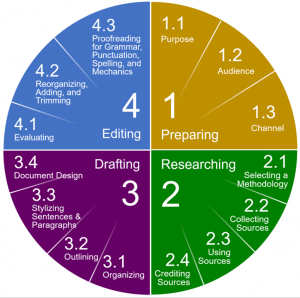Chapter 5: The Writing Process IV: Editing
The different parts of MAPS (message, audience, purpose, style), seem tidy and distinct when listed as a mnemonic (memory tool). In practice, however, your choices about any one of these areas can affect your thinking about the other parts. This means that your drafting process must include editing. Careful editing makes sure that the different parts of MAPS fit together in the best possible way. This is true whether we’re talking about formal assignments, professional interactions or even casual communication in daily life. For instance, we’ve all sent texts we immediately wished we could take back. If we took a second to re-read, revise, and edit before clicking the “send” icon, we could avoid that dreadful feeling! Without editing, any “communication solution” might only escalate problems that need to be FACED.
Consider another example with higher stakes. Every Communication professor has the experience of opening an email from a student and seeing a message that tries to solve a problem. It might be a request for more time on a due date or a request to have a grade changed. How seriously do professors take those messages?
If the message has been edited to show appropriate respect for audience, purpose, and style, professors take those messages very seriously.
If, however, the student did no editing–if that message is filled with spelling errors, missing capitalization, and grammar mistakes–there is a massive disconnect between message, audience, purpose, and style. This is especially true if the professor has already taught the class how to write a proper professional email! In those cases, the message not only is hard to read; it appears disrespectful. The lack of editing makes it hard for many professors to focus on whatever the message might be. Because it seems that the student didn’t think about audience, many professors will struggle to take that message seriously. Instead of using communication to solve a problem, that student might have created a whole new problem for themselves.
Read the sections below for more focused attention to how and why to edit.
- 5.1: Substantial Revisions
- 5.2: Proofreading for Grammar
- 5.3: Proofreading for Punctuation
- 5.4: Proofreading for Spelling
- 5.5: Proofreading for Mechanics

Figure 5: The four-stage writing process. Section 4 (the blue section) shows editing steps.

